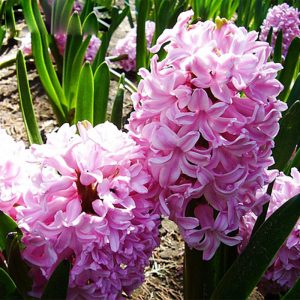The hyacinth is a plant particularly appreciated for its ornamental appearance, thanks to its special flowers, romantic and delicate.
The hyacinth has distant origins, namely from Asia Minor; its scientific name is Hyacinthus and inspired by the mythology by the story of the killing of Hyacinth by Apollo.
It ‘a bulbous plant that can be grown in this period and then last for many months, until spring.
The hyacinth has long fleshy leaves and is very famous and loved for its flowers that are harvested in the cob.
Another very special aspect is the variety of species that can also vary in flower color that can go from white to blue to purplish pink.
This is also why the hyacinth is an ideal plant for ornamental play action in the garden or in the balcony.
 Thanks to its bulbous shape, the proper maintenance, allows the user to cultivate the hyacinth year to year, appreciating it for a long time.
Thanks to its bulbous shape, the proper maintenance, allows the user to cultivate the hyacinth year to year, appreciating it for a long time.
The first thing to know is that in the nursery you can find it and buy it already in the pot, but it is advisable to directly choose the bulbs because, first they are much cheaper, then can be planted following scrupulous the best care for the plant.
The hyacinth in fact, is not a complicated plant to grow, but like all others, requires a series of essential measures to assure a lasting and healthy life.
Hyacinth: cultivation and care
The first thing to consider after buying the bulbs, is to choose the most appropriate vessel . The most suitable container is low and large in order to ensure the adequate space between a bulb and the other.
After finding the pot another very important aspect is that of the soil.
The soil should be of medium mixture, composed of humus, sand and clay. The final solution has to be fresh and well fertilized, so ensuring proper nourishment to the bulb.
Before planting out the bulb is necessary to prepare the fund that must also be composed of pebbles of medium size, what is important is to ensure complete coverage of the fund in order to have a compact layer. After the stones necessary to provide another layer of sand, again must be spread in a compact and uniform way.
Then you can move on to the soil and more specifically must be composed of 1/5 clay and 4/5 of land.
The bulb must be placed with the tip upward and must be positioned within a layer of earth of at least 4 centimeters.
After placing the bulb must cover it, but because it has to breathe is important not to cover the bulb for more than 1 cm height.
Each bulb must have at least 1 cm away from the other, so as to ensure a healthy and balanced growth without pressure from other hyacinths.
After you have completely covered the various hyacinth bulbs is important watering remembering that even the hyacinth, does not like standing water.
And ‘advisable to soak the soil once every three days in winter, and in summer even once a day.
After a few weeks you will see the first sprout shoots and, subsequently, especially in spring, you will appreciate the flowers.
Preservation and care over the years
As mentioned previously a right maintenance allows to store andreuse the hyacinth year to year.
When the flowers fade and the leaves are completely dry, simply remove the bulb from the soil and, after cleaning may be stored in a cool, dry place in order to be ready to be used again the following year.
Another important aspect is that usually, the cultivated bulbs, during their growth, produce other bulb i that, if detached, can be re-used again the following year.
Enemies and diseases
Diseases that can be found on the hyacinth are manifold. The most common features relate to the attack by fungi , the presence of insects and aphids .
Fungi produce rot and usually their presence is payable by water logging. If you notice gray spots, leaf yellowing and blackening of the bulb, try to solve the problem of stagnation and in extreme cases can even play his habitat changing the soil, so that it is cool and dry, not dry.
The green aphid is a problem you might encounter especially in spring and summer. Another important problem is generated by the bulbs flies, penetrating in the bulbs, devour them, up to bring the plant to death.
So remember that, to appreciate all kinds of hyacinth, from winter until late spring, it must scrupulously follow the actions described in the previous rows. Only then can you enjoy the plant for years, increasingly and continuously, due to the natural reproduction of the bulbs.
Tags: Hyacinth, Ornamental plant




Leave a Reply